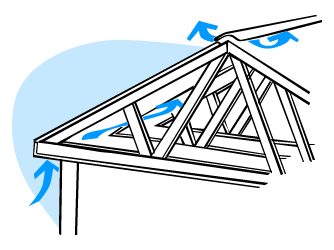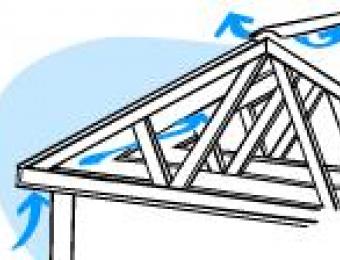
How is heat absorbed and released by the roof?
As most of us know, hot air rises. As a result, air in the roof cavity tends to be a lot warmer than the air in the rest of your house. A roof also tends to be exposed to a great deal of solar energy - that is, heat from the sun.
Roof materials vary in how much heat they absorb. For example, some materials (such as concrete) have what is known as a high thermal mass. This means they absorb and trap heat, and then release it slowly later. A material like PVC on the other hand, barely absorbs any heat at all. A light coloured PVC roof will behave very differently to a roof covered with dark coloured concrete tiles.
The roof’s role in climate control
Your heating and cooling costs can be reduced by controlling the heat trapped in the roof cavity. Lowering the temperature is as simple as encouraging warm air to exit the apex of the roof. Using the warm air to heat the house is more complicated though. A simple solution is a system that allows you to control roof vents either manually, or using a thermostat system or timer.
Another option is a heat recovery ventilation (HRV) system which collects the warm air trapped in the roof and then blows it back inside the house. These systems are beneficial as they also remove excess moisture from the air, which can be a problem in winter. In warmer months, the HRV can also be used to mechanically ventilate the roof cavity. There is some dispute over the efficiency of HRV systems, with some performing better than others, so it may pay to shop around if you are considering one.
The roof as part of the building envelope
A building envelope is often described as the ‘skin’ of a building - it is what keeps the outside separate from the inside. A building envelope is normally referred to as either 'tight' or 'loose'. A tightly sealed building envelope doesn't admit much air from the outside, while a loose envelope has a more free-flowing exchange between the air inside and outside. Although all but the warmest climates in Australia favour a more tightly sealed building envelope, a building without fresh air is not good for the occupants' health. A system of vents (some of them mounted on the roof) regulates the air flowing in and out of your home.
Good ventilation = lower cooling costs
While there will always be a few days each year made more bearable by air conditioning, for the most part, comfortable temperatures can be maintained by installing a good ventilation system. This will include vents in the soffits of the eaves, which help draw cool air into roof. This pushes the hot air upwards and out of ridge vents at the top of the roof. It is possible to rely solely on temperature exchange and air pressure to circulate the air, however the addition of some mechanical ventilation will ensure that effective circulation occurs.





